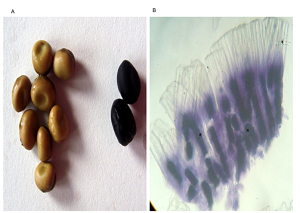Biochemical Characterization of Building Block of Condensed Tannin in Faba Bean (Vicia faba L.)
Research Article | Published: 11 January, 2019
First Page: 25
Last Page: 27
Views: 3854
Keywords: proanthocynidin, flavan-3-ols, catechin, epicatechin, anti-nutritional factor
Abstract
Despite being nutritionally rich, faba bean is not considered as commercial legume crop. One of the probable reasons for it, is the lesser acceptance due to high content of condensed tannins in seed coat. Condensed tannins are polymer of flavan-3-ols type monomers like catechin and/or epicatechin. The knowledge about these monomers is highly important to design strategies to modulate its content in target parts of the plant. In this study we first confirmed the presence of condensed tannin in seed and further its localization in seed coat by tannin specific reagent. The enzyme responsible for biosynthesis of catechin/epicatechin i.e. antocyanidin reductase, was purified from leaf extract. We further demonstrated the presence of epicatechin as monomer in seed extract of faba bean which was further confirmed by in-vitro anthocyanidin reductase catalyzed reaction using paper chromatography. The enzyme and/or gene responsible to synthesize epicatechin can now be an ideal target for reducing the amount of condensed tannin in seed coat, and hence can be useful for nutritional improvement of faba bean

References
- Dellus V, Heller W, Sandermann H and Scalbert A (1997) Dihydroflavonol 4-Reductase activity in lignocellulosic tissues. Phytochem 45 (7): 1415–1418.
- Dhingra KK, Grewal DS and Dhillon MS (1990) Performance of Faba Bean in Punjab, India. FABIS Newsletter 26: 22-24.
- Guggenheim M (1913) Dioxyphenylalanain, eine neue Aminosaeure aus Vicia faba. Zeitschr Physiol Chemie 88: 276-84.
- Kumar A, Nidhi, Prasad N and Sinha SK (2015) Nutritional and antinutritional attributes of Faba bean (Vicia faba L.) growing in Bihar, India. Physiol. Mol Biol Plants 21:159-162.
- Punyasiri PAN, Abeysinghe ISB, Kumar V, Treutter D, Duy D, Gosch C, Martens S, Forkmann G and Fischer TC (2004) Flavonoid biosynthesis in the tea plant Camellia sinensis: properties of enzymes of the prominent epicatechin and catechin pathway. Arch Biochem Biophy 431:22-30.
- Rao P, Dahiya DR and Singh RC (1984) Prospects for faba bean (Vicia faba L.) cultivation in Haryana. FABIS Newslett 10:1-2.
- Sinha SK, Kumar M, Kumar A, Bharti S and Shahi VK (2013) Antioxidant activities of different tissue extract of Faba bean (Vicia faba L.) containing phenolic compounds. Legume Res 36(6): 496-504.
- Sinha SK (2014) Faba Bean: Nutritional Values and Prospects for Trait Improvements. Advances in Plant Physiology Vol. 15, pp:402-416. A. Hemantaranjan (Ed). Scientific Publisher (India), Jodhpur, (ISSN: 0972-9917; ISBN: 978-81-7233).
- Xie DY, Sharma BS, Paiva NL, Ferreira D and Dixon RA (2003) Role of Anthocyanidin Reductase, Encoded by BANYULS in Plant Flavonoid Biosynthesis. Science 299: 396–399.
- Xie DY, Sharma SB and Dixon RA (2004) Anthocyanidin reductases from Medicago truncatula and Arabidopsis thaliana. Archieves Biochem Biophys 422: 91–102.
Author Information
Centre for Environmental Science and Engineering, Indian Institute of Technology Bombay, Mumbai-400076, India